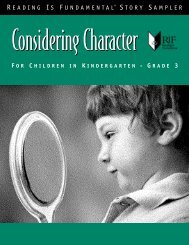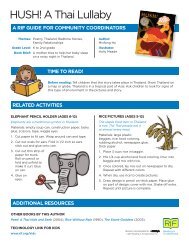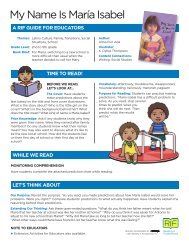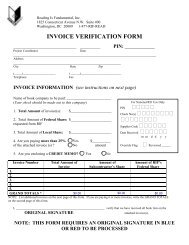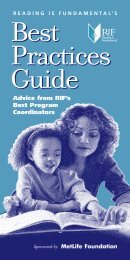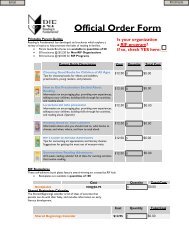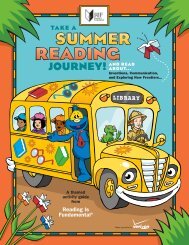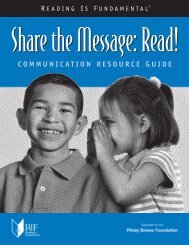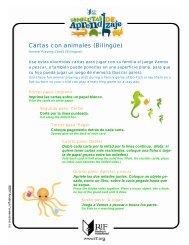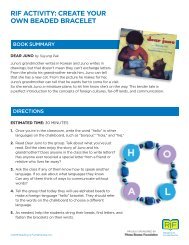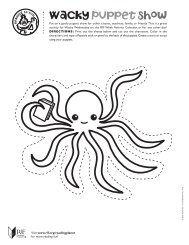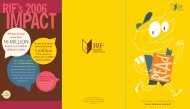Sea Turtles Story Sampler/LS - Reading Is Fundamental
Sea Turtles Story Sampler/LS - Reading Is Fundamental
Sea Turtles Story Sampler/LS - Reading Is Fundamental
- No tags were found...
You also want an ePaper? Increase the reach of your titles
YUMPU automatically turns print PDFs into web optimized ePapers that Google loves.
R EADING I S F UNDAMENTAL S T ORY S AMPLER<strong>Sea</strong> <strong>Turtles</strong>F OR C HILDREN A GES 5-12
When and How Should I Usea <strong>Story</strong> <strong>Sampler</strong>?<strong>Story</strong> <strong>Sampler</strong>s can be used within or as a supplement to acurriculum or an after-school program. They can be part ofreading challenges, reading weeks, and family involvementevents. Your imagination and the interests of the childrenwho participate in the RIF program will help determine thebest way to use the <strong>Story</strong> <strong>Sampler</strong>. Enjoy and have fun!Tips for <strong>Reading</strong> AloudBefore You Read a <strong>Story</strong>…■ Make sure everyone is comfortable■ Show the cover and read the title and author of the book■ Ask the children about the cover■ Suggest things the children can look or listen for duringthe storyDuring a <strong>Story</strong>…■ Change your voice to fit the mood or action■ Move your finger under the words as you read them■ Show the pictures and talk about the book as you read■ Add information or change words to help kids understandmore words and explain the meaning of a new word■ Ask children to make predications about the plot, thecharacters, and the setting■ Share your own thoughts about the story■ Follow the cues of the childrenAfter You Read a <strong>Story</strong>…■ Ask questions about what happened in the story■ Encourage the group to relate the story to their ownexperiences■ Ask children how they might feel or act if they were oneof the characters■ Encourage children to share their thoughts about thestory and pictures■ Extend the story with an activity or another book▲ ▲ ▲ ▲<strong>Sea</strong> <strong>Turtles</strong>A STORY SAMPLER FORCHILDREN AGES 5 - 12SEA TURTLE LIFE CYCLEInto the <strong>Sea</strong>by Brenda Z Guiberson, Henry Holt, 1996ISBN: 0805064818“The Boy Who Talked with Animals” fromThe Wonderful <strong>Story</strong> ofHenry Sugar and Six Moreby Roald Dahl, Viking Press, 1988ISBN: 0140328742HABITATThe Magic School Bus HopsHome: A Book AboutAnimal Habitatsby Patricia Relf, Scholastic Trade, 1995ISBN: 0590484133One Small Square – Coral Reefby Donald M. Silver, McGraw-Hill, 1997ISBN: 0070579709MIGRATIONThe Journey of a Turtleby Carolyn Scrace, Watts, 2000ISBN: 053115419XBartleby of the MightyMississippiby Phyllis Shalant, Dutton Children’s Books, 2000ISBN: 0525460330CONSERVATIONAnd Still the Turtle Watchedby Sheila MacGill-Callahan, Dial Books forYoung Readers, 1991ISBN: 0140558365The Turtle Watchersby Pamela Powell, Penguin, 1994ISBN: 01403707732
Community Connection■ Invite a local veterinarian, conservationist or marine biologist totalk about an aspect that may be related to sea turtles, either thecare of them or perhaps the preservation of their environment.Additional Titles<strong>Sea</strong> <strong>Turtles</strong> by Gail Gibbons, Holiday House, 1995ISBN: 082341373XIn her usual simple and straightforward format, Gail Gibbonsdescribes good solid information about sea turtles as well as someof the dangers to their survival.<strong>Turtles</strong> and Snails (First Discovery Books) by GallimardJeunesse, Scholastic Trade, 1998ISBN: 0590117645Colorful, transparent pages offer lots of interesting informationabout different types of turtles and snails.Look Out for <strong>Turtles</strong> by Melvin Berger, HarperCollins, 1992ISBN: 0064451569Look out for turtles, all kinds of turtles! Melvin Berger introducesdifferent species of turtles with fun detailed illustrations.The Magic School Bus Gets Cold Feet: A Book About Warm andCold - Blooded Animals by Tracey West, Scholastic Trade, 1997ISBN: 0590397249Liz, the classroom lizard, is missing and all the children think shehas been kidnapped, but Ms. Frizzle knows the truth! Instead oftelling the children where Liz has gone, she lets the kids figure itout the scientific way.Follow the Moon by Sarah Weeks, HarperCollins JuvenileBooks, 1995ISBN: 0060244429Bright beachfront lights can easily disorient a baby sea turtle onher way to the ocean. The story by Sarah Weeks tells of a youngboy who helps a little lost sea turtle back to her natural habitat.The Turtle and the Moon by Charles Turner, Penguin, 1996ISBN: 0140558128A nice story about a turtle that plays with the moon’s reflectionin the water, beautifully illustrated.Turtle Bay by Saviour Pirotta, Farrar, 1997ISBN: 0374378886A story of friendship between an old man and a young boy thatinvolves the nesting of sea turtles in Japan.What Newt Could Do for Turtle by Jonathan London,Candlewick Press, 1996ISBN: 0763605808A turtle and a newt may make an unlikely pair but they becomebest of friends.Shy Little Turtle by Howard Goldsmith, McGraw-Hill, 1997ISBN: 007024541XComing out of his shell helps shy little turtle discover the worldaround him.CHILDREN AGES 8 -12“The Boy Who Talked with Animals” fromThe Wonderful<strong>Story</strong> of HenrySugar and Six Moreby Roald DahlViking Press, 1988ISBN: 0140328742Roald Dahl is an incredible story tellerwell known for many of his stories likeCharlie and the Chocolate Factory, Jamesand the Giant Peach and Matilda to namea few, but in this book, he shares severalshort stories that are a combination offact and fiction. One of the stories, “TheBoy Who Talked with Animals”, is abouta little boy who saves a sea turtle frombecoming a meal for the local tourists ofthe West Indies.5
What To Do Before <strong>Reading</strong> the <strong>Story</strong>■ Many of the children will not only be familiar with RoaldDahl’s stories but will be eager to dive right in and startreading. Introduce the story as part of a collection of shortstories and either read aloud to the group or have them readalong as you read.■ Because the title does not give away the subject of sea turtles,you may not want to mention it at all. Simply start readingand address the topic using the questions in the After the<strong>Story</strong> section.Things To Talk About During the <strong>Story</strong>■ The narrator begins by telling the reader of his visit to Jamaica,an island in the West Indies. If the children are not familiarwith the location of the island, pull out a map and point it out.Briefly discuss the climate, local population and ask if anyonein your group has ever been to the West Indies.■ The guests on the hotel’s beach are fighting about who will getthe turtle and what they will do with it. Ask your readers howthey feel about all the characters that are described. Point outthe language that Dahl uses to paint a picture of the scene andits inhabitants. (His writing seems to show a bit of disdain forthe tourists.)■ Ask the group why they think the hotel manager agrees to sellthe turtle to the little boy’s father, is it for the money or is heintrigued by the fact that the boy can calm the turtle bytalking to it?What You Can Do When You Finish<strong>Reading</strong> the <strong>Story</strong>■ There are many ways to begin talking about sea turtles fromthis story, but the first is to mention that the turtle in the storyis probably a sea turtle.■ Explain to the children that although the story is most likelyfictional, you are fairly confident that the main character is asea turtle because of several details that were mentioned inthe story.A Fact Finding Mission…■ Before telling the group what clues were given to make youthink that it is a sea turtle, have them do a little detective workon their own.■ Gather some of the books from the Additional Titles list and askthem to collect a few major facts about sea turtles, then calltheir attention to the story and ask what they think drew you toyour conclusion. Migration location of the West Indies, oceanhabitat, its’ large size, the description of thick flippers, notclaws, and the mention by the author of the turtle’s probableold age are a few of the details that seem to point to the factthat it is a sea turtle. If your group is still curious after they havedone a little sleuthing, have them become scientists and findout how sea turtles are classified.Are You a Believer?■ Older children are usually aware of the difference between realityand fantasy and have a better sense of where they are in time.Roald Dahl’s story of “The Boy Who Talked with Animals” is aninteresting place for older readers to begin discussing the subjectof sea turtles because of their more advanced comprehensionlevel. However, it can also be a good opportunity for some creativewriting to take place. Ask the kids to imagine that they are eitherthe little boy or the turtle. Either on their own or in pairs, askthem to script a conversation between the two characters. Whatwould the turtle say? What would the young boy say to the turtle?If you have a chance, have the group act out their dialogues.Family Involvement■ Roald Dahl has written many fantasy filled, silly stories andsome of them have been made into movies. Rent Charlie andthe Chocolate Factory or James and the Giant Peach and sit withsome popcorn and enjoy the adventure with the whole family!■ Play <strong>Sea</strong> Turtle-Pictionary! Download the game from the <strong>Sea</strong>Turtle Survival League’s web sitehttp://www.cccturtle.org/ccctmp.htm.Community Connection■ Write for some additional information on sea turtles. Contactthe Florida Department of Natural Resources,Division ofMarine Resources, Florida Marine Research Institute, 100Eighth Avenue, S.E., St. Petersburg, FL 33701, 813-896-8626 ortry the <strong>Sea</strong> Turtle Restoration Project, 300 Broadway, SanFrancisco, CA 94133, (800) 859-SAVE.Additional TitlesHonu by Marion Coste, University of Hawaii, 1994ISBN: 0824815076A good book for somewhat older readers that offers details abouta green sea turtle.<strong>Sea</strong> <strong>Turtles</strong> by Jeff Ripple, Voyageur Press, 1996ISBN: 0896583155Recommended as a fantastic introduction to sea turtles, the bookhas amazing photographs to capture the reader.<strong>Turtles</strong> by Anita Baskin-Salzberg & Allen Salzberg, WattsFranklin, 1998ISBN: 0531158985A great resource book for all readers that provides photographsand clear, concise information about different types of turtles.<strong>Sea</strong> <strong>Turtles</strong> by Lorraine A. Jay, Creative PublishingInternational, 2000ISBN: 1559717467Lorraine Jay provides the most recent research findings on seaturtles as well as a helpful index and an Internet site list.6
HabitatCHILDREN AGES 5-8The Magic SchoolBus Hops Home:A Book AboutAnimal Habitatsby Patricia RelfScholastic Trade, 1995ISBN: 0590484133Ms. Frizzle is up to her adventurous waysof teaching once again. When Wanda’s bestfriend Bella the bullfrog disappears, thechildren take a ride on the Magic SchoolBus to find out where she has gone. Hopon board as they find out all about animalhabitats.Things To Talk About During the <strong>Story</strong>■ Although the story stars Bella the bullfrog, the book coversthe main features of animal habitats. As you read, extract thecomponents of habitats such as environment, food, changesin habitat made by the animal or particular preferences ofthe animal.■ Point out how Ms. Frizzle and her class are transformed inorder to experience life as a frog!■ Discuss some of the challenges that they face as they go on theirsearch and rescue mission for Bella.What You Can Do When You Finish<strong>Reading</strong> the <strong>Story</strong>■ Ask the children if they have ever seen any animals, reptiles orbirds in their natural habitat. Ask them to describe what theyhave seen and if the habitat was disturbed by anything.■ Talk about the habitats of humans. What kinds of needs do wehave and how are some people’s habitats different from others.Discuss how climate, occupation and the part of the countrycan affect these differences, but also how human preferencescan determine habitat as well.■ Because the book does not feature sea turtles, take the habitatcomponents that you and the children have extracted from thestory and try to fill in the same information for sea turtles. Thebooks from the Additional Titles list should be quite helpful incompleting this task.What To Do Before <strong>Reading</strong> the <strong>Story</strong>■ If the children are not familiar with the Magic School Busseries, you may want to provide a little background on thecrazy antics of Ms. Frizzle! There are many topics that theseries covers as well as the videos that are also available toshow the children.■ Ask the children if they know what the word habitat means.(The neighborhood in which a group of plants and animalslive and interact.)7
CHILDREN AGES 8-12One Small Square— Coral Reefby Donald M. SilverMcGraw-Hill, 1997ISBN: 0070579709The One Small Square series by Donald Silverare colorful, informative and fun to read.Young and older children will find these booksa great source of information and learn plentyabout the various aquatic environments.What To Do Before <strong>Reading</strong> the <strong>Story</strong>■ The book begins with the author making a comparisonbetween the coral reef and the circus. Discuss the reasons whythe author may begin the book by making that comparison.Ask the group what they already know about coral reefs andseashores.■ Point out that coral reefs and seashores, in addition to the vastocean, are the natural habitat for many different animals andfish, the sea turtle being one of them.Things To Talk About During the <strong>Story</strong>■ The book has great illustrations and detailed descriptions ofthe creatures and plants that thrive underwater. The text alsodescribes some of the dangers that the sea creatures face ona daily basis.What You Can Do When You Finish<strong>Reading</strong> the <strong>Story</strong>■ Although this book only features a sea turtle on one page, itcovers in detail some of the world the sea turtle inhabits. Afteryou have finished reading about the coral reef, try some of thebooks from the Additional Titles list to enrich a discussionabout the sea turtle’s habitat.■ Add to the discussion some of the facts from the <strong>Sea</strong> TurtleSurvival League’s web site such as:● <strong>Sea</strong> turtles are solitary creatures for the most part.● They tend to remain under water for a large part of the timethat they are at sea and only interact with other sea turtleswhen they intend to mate.● <strong>Sea</strong> turtles eat and rest on and off throughout a typical day.● They can sleep floating on the surface of the water or tuckedaway under reefs or rocky areas.● <strong>Sea</strong> turtles can migrate hundreds or even thousands of mileswhen they are not nesting or mating.■ The book discusses the concept of damage to the environmentonly briefly; however, you may want to touch on this subjectwith the children as it pertains to the habitat and survival ofthe sea turtles.■ In addition to the ocean habitat of the sea turtles, they alsospend a small part of their life on the beach. <strong>Sea</strong> turtles oftenreturn to the same beach where they were born to nest theirown eggs. Only the females nest and most often they lay andbury their eggs at night. Discuss the process of constructing thenest, laying and burying the eggs, incubation and the emergencefrom the nest of the baby sea turtles as well as the fact that thehabitats in which they nest are becoming endangered due tocoastal armoring, beach nourishment and pollution.9
Family Involvement■ Take a look inside your garage or under your sink. Tally up theamount of motor oil, lawn fertilizers, cleaning supplies andpaints that contain chemicals, and see if you can try to reducethe use of these chemicals. Toxins and chemicals that are notdisposed of properly sometimes end up washing up on beachesor coastal lagoons. The pollution then harms the inhabitants ofthe waters and the beaches.Community Connection■ Write a letter to the local newspaper informing the communityof the importance of protecting the sea turtles habitat.Encourage readers to do their part by keeping the oceans andthe beaches clean. If you happen to live near a beachcommunity, ask the people with beach front lights to keepthem off during nesting season and to keep the beaches free ofcoastal armoring or anything that might prevent the sea turtlesfrom successfully nesting.Additional TitlesOn the Trail of <strong>Sea</strong> <strong>Turtles</strong> (Barron’s Educational Series) byBernard De Wetter, Incorporated, 1999ISBN: 0764111620This book serves as a guide to those who want to follow andobserve sea turtles. It also provides great information about thesea turtle’s anatomy, feeding habitats, global location andecological status.<strong>Sea</strong> <strong>Turtles</strong> by Emilie U. Lepthien, Children’s Press, 1997ISBN: 0516261134Yet another sea turtle book that offers good information forsomewhat older readers.Feeding On a Food Chain!■ Part of what determines an animal’s habitat is the availability ofthe food that it consumes. <strong>Sea</strong> turtles like to eat seaweed, fish,crabs and jellyfish, discuss what the sea turtle likes to eat andhow and where they can find these things. Unfortunately, thereare also predators that like to eat the sea turtles themselves, createa food chain and see where all the different sea creatures fit in.Picky, Picky, Picky…. Habitat Preferences■ Each species of sea turtles eats, sleeps, mates and swims indifferent areas. Have the kids do a bit of research and find outmore about the specific habitats of each type of sea turtle.(Loggerhead, Green turtles, Hawksbills, Kemp’s Ridley, OliveRidleys, Flatbacks, and Leatherbacks)HINT: The <strong>Sea</strong> Turtle’s Survival League and the book <strong>Turtles</strong> byAnita Baskin-Salzberg & Allen Salzberg offer easy to findinformation about the specific habitats of the various species.One Small Square — <strong>Sea</strong>shore by Donald M. Silver,McGraw-Hill, 1993ISBN: 0070579288The One Small Square series by Donald Silver is colorful,informative and fun to read. Young and older children will findthese books a great source of information and learn plenty aboutthe various aquatic environments.MacMillan Animal Encyclopedia for Children by Roger Few,Simon & Schuster Children’s, 1991ISBN: 0027624250A beginning reference book that tells of 11 major habitats and thevarious animals that live there.Adapting to the Environment by Fulvio Cerfolli,Raintree Steck-Vaughn Publishers, 1998ISBN: 0817241965The title tells it all, this book describes how animals in differentregions adapt to their environment in order to survive.10
MigrationCHILDREN AGES 5-8The Journeyof a Turtleby Carolyn ScraceWatts, 2000ISBN: 053115419XPart of a series of books on animalmigration, Carolyn Scrace does a great jobof describing the travels as well as thedevelopment of the green turtle.What To Do Before <strong>Reading</strong> the <strong>Story</strong>■ Explain to the children that some animals are born, grow andremain in the same place all their lives; however, certainanimals move to different places throughout their existence.This journey is called migration.■ Ask the children to make some predictions as to the reasonswhy an animal might need to move around. (habitat, climate/weather, food availability, reproduction, endangered survival)■ Ask the children why sea turtles in particular, might migrateand where they might go on their journey. Introduce the storyfollowing the brief discussion.Things To Talk About During the <strong>Story</strong>■ Because the book is a non-fiction book and serves as a resourcefor information on sea turtles, show the kids the table of contentsin the beginning of the book. Read a few of the topics from thelist and the corresponding pages. If the children are not familiarwith the use of the table of contents, explain how informationalbooks are often organized so that the reader can go to a specificpage to find out what he/she needs to know.■ The story has wonderful illustrations and fairly large print,great for beginning readers.■ The book mentions that turtles leave their feeding groundswhen the weather gets colder, ask the children if they know ofany other animals that also migrate when the weather changes.Ask them why they think the animals might move on when theweather changes. Where are the turtles headed on their journey?Why do some of the turtles not complete their migration?(The illustrations on the very last page may provide some hints.)What You Can Do When You Finish<strong>Reading</strong> the <strong>Story</strong>■ Use the map at the back of the book to take a look at wheremost sea turtles migrate. Discuss the characteristics of that areaof the world and why it is a good home for the sea turtles.■ The end of the book also contains a page of “Turtle Words” thatwill be helpful to review with young children.<strong>Sea</strong> Turtle Survival League■ Visit the <strong>Sea</strong> Turtle Survival League web page,http://www.cccturtle.org/, and try out some of the great activitiesand worksheets that you can download and print off theInternet. Worksheet #1 is an illustrated maze that features someof the dangers that a young sea turtle might encounter. Childrenneed to help with the turtle’s migration process by figuring outhow to get the turtle back to a safe habitat.■ Use the web site http://www.cccturtle.org/ to track some ofthe turtles or to take a look at photographs of the process thatscientists and conservationists use to track the sea turtlesmigration.11
Watch Out!■ Try a little role-playing. Have some of the children pretend tobe sea turtles acting out the sea turtle life cycle. Ask some of theother children to pretend to be natural predators of the seaturtle like crabs, birds and snakes or man-made threats to thesea turtles such as nets or chemical pollution, and then asksome of the other children to pretend to be food for the seaturtles. Children love to be melodramatic, get them into themood by adding some striking classical music or perhaps theinfamous “Jaws” theme while they perform.Family Involvement■ <strong>Sea</strong> turtles migrate to mate, nest and lay their eggs. They usuallyreturn to the same breeding grounds and females usually laytheir eggs on the same beach where they were born. Youngchildren love to hear the story about when and where they wereborn. Migrate to the place where your child was born anddescribe what it was like the day they came into the world. Likethe sea turtles, parents with more than one child also often givebirth in the same place!■ <strong>Sea</strong> turtles also migrate to find food in new feeding grounds.Does your family ever make a special trip for a favorite meal?Follow your taste buds to your most loved restaurant and enjoya fun family outing.Community Connection■ If you happen to live near a beach community where sea turtlesnest, try to find out when they nest and on what part of thebeach. Sometimes local conservationists or scientists will havethis information and will organize a nighttime watch of thenesting and hatching process. Check with a local conservationistgroup to see if they offer organized turtle walks.Additional Titles<strong>Sea</strong> Turtle Journey: The <strong>Story</strong> of a Loggerhead Turtleby Lorraine A. Jay, Trudy Corporations, 1995ISBN: 1568991894This pocketsize book describes the journey of a loggerhead seaturtle from birth to the nesting of her very own eggs.Animals on the Move (Rookie Read-About Science)by Allan Fowler, Children’s Press, 2000ISBN: 0516215892Why and how do animals migrate? Find out in this book from theRookie Read About collection.Animal Journeys (Nature Club) by Joyce Pope, Troll Assoc, 1993ISBN: 0816727783Just like people, animals make preparations for their journeys too,children will find out more about the migration process by readingJoyce Pope’s Animal Journeys.CHILDREN AGES 8-12Bartleby of theMighty Mississippiby Phyllis ShalantDutton Children’s Books, 2000.ISBN: 0525460330Although Bartleby is not a sea turtle,this light and somewhat humanlike storyaddresses the scary as well as thrillingchallenges that a turtle might come upagainst while entering a brand new worldand trying to reach a particular destination.What To Do Before <strong>Reading</strong> the <strong>Story</strong>■ Read the title of the story to the group and point out wherethe Mississippi River is on a map of the United States. Thenpoint out where most sea turtles migrate to and from theirnatural habitat. The children will then see that sea turtlesare not found in the Mississippi River. (The MississippiRiver is a freshwater body of water and sea turtles live insaltwater.) Ask the kids then why the title is called Bartlebyof the Mighty Mississippi? The story is not only fictional,but it is also about a turtle — not a sea turtle.■ Read the inside leaf of the book so that the children cangain a better sense of what the story is about and then askthem to make some predictions about the story.Things To Talk About Duringthe <strong>Story</strong>■ Bartleby starts out as a pet of three little, somewhatirresponsible boys. He is not taken care of in the mostdesirable way and ends up being left by the local pond nearthe family’s house. Since he has never been an outdoorpet, he must learn how to adapt to his new environment.■ As you read, ask the kids to keep in mind the fact thatBartleby is not a sea turtle. Make some comparisons withBartleby’s new habitat, food choices and the dangers to hissurvival that a typical sea turtle would encounter.12
■ Talk about some of thethings that Bartleby islearning and brainstormsome things that a seaturtle might have toadapt to if put in asimilar situation.■ Remember sea turtlescannot be pets becausethey are protected by law!What You Can DoWhen You Finish <strong>Reading</strong> the <strong>Story</strong>■ In addition to a story about a turtle, this is also a story about afriendship that develops and how one friend risks his life forthe other. Although this does not directly deal with the topic ofsea turtles, you may want to have a discussion about whathappens to Bartleby and his friend Seezer.■ Ask the group about some of the challenges that Bartleby facesas he tries, unrealistically, to make it to the mighty Mississippi.Then discuss some of the challenges that sea turtles face as theyattempt to migrate.■ Both of the latter discussions may lead to the conclusion thatwe need to respect animals and help protect them against themany dangers, natural and man-made, that they face.The Mighty Mississippi or Bust!■ Do a little research on the places sea turtles migrate. What is itabout the climate, the water, the beaches or the prey that makeit easy for the sea turtles to mate, nest or feed?Finding Your Place in the World….■ <strong>Sea</strong> turtles have to overcome certain obstacles when theyattempt to migrate. Despite strong currents, a lack of visiblelandmarks, limited vision, and the fact that they can only lifttheir heads a few inches out of the water, sea turtles navigatethousands of miles and often return to the exact same beachwhere they were born. This extraordinary ability has baffledscientists until recently. Now it is believed that sea turtles areable to detect the angle and the intensity of the earth’s magneticfield. Although it is a theory that has yet to be proven,experiments suggest that the sea turtles are able to determinelatitude and longitude and thus find any particular location inthe world. Find out more about how researchers have come tothis conclusion using satellite telemetry.Follow the <strong>Turtles</strong>!■ Check out the <strong>Sea</strong> Turtle Educational Tracking Program on theInternet http://www.cccturtle.org/sat1.htm. Discuss why beingable to track the sea turtles would be beneficial to their survival.Try the longitude/latitude activity to plot the turtle locations.Family Involvement■ Owning and caring for a pet can be more responsibility thanmost children realize. Visit your local library to check out somebooks on the animal that your children may want and find outmore about the food they like to eat, their behavior and theirpreferred habitat. Your local pet storeowner may also havesome interesting information to share with your family aboutyour future pet.Community Connection■ Take a look around your local community. Have most of thepeople who live there always lived there or have they migratedfrom somewhere else? Find out about what it is that attractspeople to your community. <strong>Is</strong> it the climate, the food, the localtourist attractions or something else?■ If there are animals, reptiles or birds that are particular to yourcommunity, find out why they tend to migrate, what is it thatdraws them to the area?Additional TitlesThey Swim the <strong>Sea</strong>s: The Mystery of Animal Migrationby Seymour Simon, Browndeer Press, 1998ISBN: 015292888XSeymour Simon has written about a variety of topics and alwaysin a clear, well-detailed manner that captures the attention ofchildren. In this particular book, Simon describes mysteriouscreatures and their habitats and migratory tendencies.Animal Journeys: Life Cycles and Migrations (Animals in theWild) by Susanne Riha, Blackbirch Marketing, 1999ISBN: 1567114261In addition to turtles, this colorful spread features the life cyclesof several animals.<strong>Sea</strong> <strong>Turtles</strong>: The Watcher’s Guide by M. Timothy O’keefe,Larsen’s Outdoor Publishing, 1995ISBN: 0936513470Conservationists, scientists and researchers have been observingthe sea turtles for years in order to find out more about such asplendid creature, with the help of this guide, now you can be anexpert observer too!<strong>Sea</strong>rch for the Great Turtle Mother by Jack Rudloe,Pineapple Press Inc, 1995ISBN: 1561640727The author of this book discusses the possible role of rocks andmagnetism in the migration of the sea turtle.13
ConservationCHILDREN AGES 5-8And Still theTurtle Watchedby Sheila MacGill-CallahanDial Books for Young Readers, 1991ISBN: 0140558365A long time ago, before there were cars,airplanes, artificially made food or paint,a turtle was carved in stone by a NativeAmerican. As the years pass, the turtlewatches as people pollute the earth,waste the natural resources and threatenhis existence by destroying the land.Nevertheless the turtle survives all thenegative influences. The story emphasizesall the environmental changes that haveendangered the earth over the years, yetit can also be used to highlight how longthe turtle has sustained life on earth.14
What To Do Before <strong>Reading</strong> the <strong>Story</strong>■ Ask the children how long they think sea turtles have beenroaming the earth.■ Briefly discuss what kinds of changes have occurred that wouldaffect the existence of the turtle.■ The story opens with a Native American carving a rock into theshape of a turtle, if you are able, share actual hand carved itemswith the children to give them a sense of what they feel andlook like. If not, grab some books with photographs of carvingsfor the kids to see.Things To Talk About During the <strong>Story</strong>■ Explain the passage of time throughout the story, discuss someof the reasons why fewer people visited the turtle, why the treesthat surround him are cut down, why the white water turnsbrown or why the turtle begins to weep.■ Ask the children about the gentleman who comes along andsees the turtle underneath all the graffiti and has him broughtto a garden. Why does he rescue the turtle? What are peoplecalled that rescue animals? Or that try to preserve the environment?■ The turtle is cleaned up towards the end of the story, talk abouthow this can be done. Discuss where the turtle lives now andwhy he is kept there.What You Can Do When You Finish<strong>Reading</strong> the <strong>Story</strong>■ The story’s main focus is the environment and how it has beenthreatened by all the harmful changes to the earth over theyears. Discuss the topic of the environment and how it connectsto the endangered state of the sea turtles as well as its longevityhere on earth.■ Use the book by Gail Gibbons, Prehistoric Animals,to point outthat the turtle is one of the prehistoric animals that livedmillions of years ago and that still exists today.■ The first few pages of the book <strong>Sea</strong> <strong>Turtles</strong>, also by GailGibbons, describes how sea turtles lived over 200 million yearsago when the dinosaurs still roamed the earth. It also explainshow over time, sea turtles have evolved into smaller creaturesthan they used to be millions of years ago. Discuss the processof adapting to the environment over time. Use the book byAliki, Fossils Tell of Long Ago, in order to explain how we areable to learn about the type of sea turtles that lived during theprehistoric age.Family Involvement■ The Smithsonian National Museum of Natural Historyhttp://www.mnh.si.edu/nmnhweb.html and The IndianaAcademy / Ball State University http://www.bsu.edu/teachers/academy/ have partnered to create a series of electronic fieldtrips, one of which is The Mystery Migration: Tracking <strong>Sea</strong><strong>Turtles</strong>.Check out http://www.bsu.edu/teachers/academy/trips.html to find out the dates and times when you can take atour and follow the sea turtles.■ Sit down with an older family member and talk about how theenvironment has changed during their lifetime. Ask them ifthey feel the changes have been good or bad and how they haveadapted to them. Ask them what they would, if they could, doto change the environment for the better.Community Connection■ Take a look around your community. Do you see graffiti,pollution or waste? Write letters to your local officials, createnewsletters to distribute in your community or create posters tohang in local businesses windows to help raise awareness of thedangers that not only sea turtles face when their environment ischanged or destroyed, but that affect humans as well. Raisingawareness may help to change people’s behavior and thus helpthe conservation of the sea turtles and the lives of people inyour community.Additional TitlesTammy Turtle: A Tale of Saving <strong>Sea</strong> <strong>Turtles</strong> by Suzanne Tate,Nags Head Art, Inc., 1995ISBN: 1878405055A cute story that follows the life of a sea turtle from hatching outof her leathery shell to nesting her own young on the same beachwhere she was born.Endangered Animals (First Discovery Books) by Wendy Barish,Scholastic Trade, 1997ISBN: 0590962140World Water Watch by Michelle Koch, Mulberry Books, 1999ISBN: 0688166970A sweet and simple book that devotes a few pages to seaturtles and the threats to their survival.Making History With Your Hand!■ Use Plaster of Paris or clay to make imprints of various thingsin your environment or of the children’s hands or feet. Whenthe molds have dried, explain how this process is somewhatsimilar to the imprints and fossils that were left by creatures inthe prehistoric age. Paleontologists use these fossils to learnabout prehistoric animals as well as the evolution of variousspecies like the sea turtle.15
CHILDREN AGES 8-12The TurtleWatchersby Pamela PowellPenguin, 1994ISBN: 0140370773Three sisters watch and protect as aleatherback sea turtle lays her eggs on thebeach near their home. They must guardthe eggs from natural as well as man-madethreats to the baby sea turtles survival.What To Do Before <strong>Reading</strong> the <strong>Story</strong>■ The cover of the book shows three girls watching the sand witha flashlight. If you look closely, you can see that the sand haslittle bumps and by reading the title, the reader can guess thatthe small moving bumps are sea turtles. The caption at thebottom of the cover reads “It’s up to three girls to make sure anendangered species survives.” As you point out all the detailsthat the cover provides to the group of children, ask them ifthey know what it means to be an endangered species?■ Spend some time discussing what it means for an animal tobe an endangered species. What are some of the causes ofendangerment? What animals are currently consideredendangered? What are some animals that were at one time anendangered species, that are now extinct?■ Get a little more specific and ask the children why sea turtlesmight be an endangered species? Why has the population ofthe sea turtles been decreasing over the years?■ Remind the kids that sea turtles have been around for millionsof years, and have evolved and adapted to the environment inorder to survive. Briefly discuss how they have changed overthe years.■ Read aloud or have the children read the back of the book inorder to find out what threatens the survival of the sea turtlesin this story.Things To Talk About During the <strong>Story</strong>■ Ask the children where the story takes place? If you havealready talked about the habitat and migratory habits of the seaturtles then point out to the group that the beginning scene inthe story is not out of the ordinary for the environment inwhich the three sisters live in.■ Show the children on a map where the story is taking place andbriefly discuss the climate and culture of the Caribbean.■ The book opens with three little girls watching the sand withanticipation. They have begged their mother for permission tostay up and watch the sea turtle lay her eggs. The night is filledwith excitement as the girls shine their flashlight and watch asthe almost extinct leatherback crawls up on the beach, digs adeep and narrow hole and lays over a hundred eggs, covers thehole up and waddles back to the sea. The girls sleep well havingwitnessed this wonderful event, but they wake to find that theirdeveloping baby sea turtles are in danger and they must help toprotect them from harm.■ As you read along with the children, collect facts about the seaturtle that the three sisters gather on their S.O.S. mission.■ What other twists develop as the plot to save the turtles thickens?■ Who becomes the villain and is there a villain that becomes a hero?What You Can Do When You Finish<strong>Reading</strong> the <strong>Story</strong>■ What kind of clever thinking do the girls do in order to savethe sea turtles?■ Aside from the poachers, what are some of the other threats tothe sea turtle’s survival? Natural and man-made?■ The children in the story are very brave in their efforts to savethe turtles, what kinds of things do they do? What kinds ofthings could you and the children do in order to save anendangered species like the sea turtle?■ The story also describes the beginning of a newly discoveredfriendship with Mister Henderson, how and why does thishappen?■ In addition to the danger that the poachers create, the islandalso carries mysterious legends of the past. How do the sistershandle the island ghost stories and why does the author includethis particular detail in the story?■ How does Mister Henderson’s deceased wife factor in to thesea turtle’s plight?Adopt a Turtle!■ Adopt a turtle to help support sea turtle conservation. Use the<strong>Sea</strong> Turtle Survival League’s web site to get an application toadopt a turtle. The fee usually ranges between $25 and $30. Bakecupcakes that look like sea turtles and sell them, create beautifulwater color posters and auction them off to the highest bidderor draw the outline of a giant sea turtle and fill it with differentcolor wood chips that can be sold for a few cents each. Holding afundraiser of some sort should bring in enough for your class,school or group of children to adopt a sea turtle.16
Family Involvement■ The crisis of the sea turtles brings together the sisters in thisstory with an old man they fear. As their friendship develops,the girls get to know the older man and are able to put to restan eerie legend that has persisted through the years. Are therescary stories or particular legends that have been passed downin your family? <strong>Story</strong>telling is a great way to share some historyor just some plain old fun with family members. Retell somestories that you know or make up one that will grab yourchild’s attention and make them want to hear more!Community Connection■ Invite a local environmentalist or conservationist or if you livenear a university, a professor of environmental studies to speakabout the impact we as humans have on our planet. Ask theguest to speak about what threatens our environment as well asthe sea turtles and what we can do about it.■ The following web sites have excellent resources and offer greatways to get involved either on a local or a national level:<strong>Sea</strong> Turtle Restoration Project www.seaturtles.org/This particular web site provides fantastic links to otherorganizations that deal with sea turtle issues and conservationand environmental issues.Turtle Trax www.turtles.orgThis web site presents an abundance of information on seaturtles and ways to track the migration of several currentlytagged sea turtles.Caribbean Conservation Corporation www.cccturtle.orgThis web site recommends many different activities as well as awealth of information on sea turtle habitats, migration, threats tosurvival, conservation and the nesting process.Additional TitlesStart an Awareness Campaign!■ The three little sisters in the story make a tremendous effortto save the turtle eggs, but they realize that they cannotprotect every sea turtle clutch of eggs. In an effort to saveeven more sea turtles, they begin an awareness campaigntargeting the local tourists who buy the crafts that are madefrom the shell of the sea turtle. Begin an awareness campaignwith your group of children. Discuss the different levels atwhich action can be taken such as federal, state and local.Decide which audience you want to target and what messageyou want to send and make a plan of action. Write letters,create a catchy slogan, paint posters or perhaps have a sit-inon the beach that will raise awareness regarding the plightof the sea turtles.<strong>Sea</strong> <strong>Turtles</strong>: Past and Present (Prehistoric Animals and TheirModern Day Relatives) by Marianne Johnston,Rosen Publishing Group, 2000ISBN: 0823952053Tracks in the Sand by Loreen Leedy,Doubleday & Company, Incorporated, 1993ISBN: 038530658XThe Windward Road: Adventures of a Naturalist on RemoteCaribbean Shores by Archie Carr, University Press of Florida, 1979,ISBN: 0813006392Decline of the <strong>Sea</strong> <strong>Turtles</strong>: Causes and Prevention. NationalResearch Council, National Academy Press, 1990ISBN: 030904247X
RIF’S MISSION<strong>Reading</strong> <strong>Is</strong> <strong>Fundamental</strong>, Inc. (RIF) develops and deliverschildren’s and family literacy programs that help prepareyoung children for reading and motivate older childrento read. Through a national network of teachers, parents,and community volunteers, RIF programs provide booksand other essential literacy resources to children at nocost to them or their families. RIF’s highest priority is thenation’s neediest children, from infancy to age 11.ABOUT RIFFounded in 1966 in Washington, D.C., RIF is thenation’s oldest and largest nonprofit children’s literacyorganization, with programs operating nationwide in16,500 schools, child-care centers, libraries, hospitals,clinics, migrant worker camps, Head Start and Even Startprograms, homeless shelters, and detention centers.RIF serves more than 3.5 million children through anetwork of more than 240,000 volunteers. Two-thirds ofthe children served by RIF have economic or learningneeds that put them at risk of failing to achieve basiceducational goals.Through a contract with the U.S. Department ofEducation, RIF provides federal matching funds tothousands of school and community-based organizationsthat sponsor RIF programs. RIF also receives privatesupport from hundreds of corporations and foundations,thousands of local organizations and businesses, andcountless individuals.RIF distributes about 13 million books a year. By theend of 2000, RIF will have placed more than 200 millionbooks in the hands and homes of America’s children.<strong>Reading</strong> <strong>Is</strong> <strong>Fundamental</strong>, Inc.1825 Connecticut Avenue, N. W., Suite 400Washington, D.C. 20009-5726Toll free: 877-743-7323Web site: www.rif.org©2000 <strong>Reading</strong> <strong>Is</strong> <strong>Fundamental</strong>, Inc.All rights reserved.




